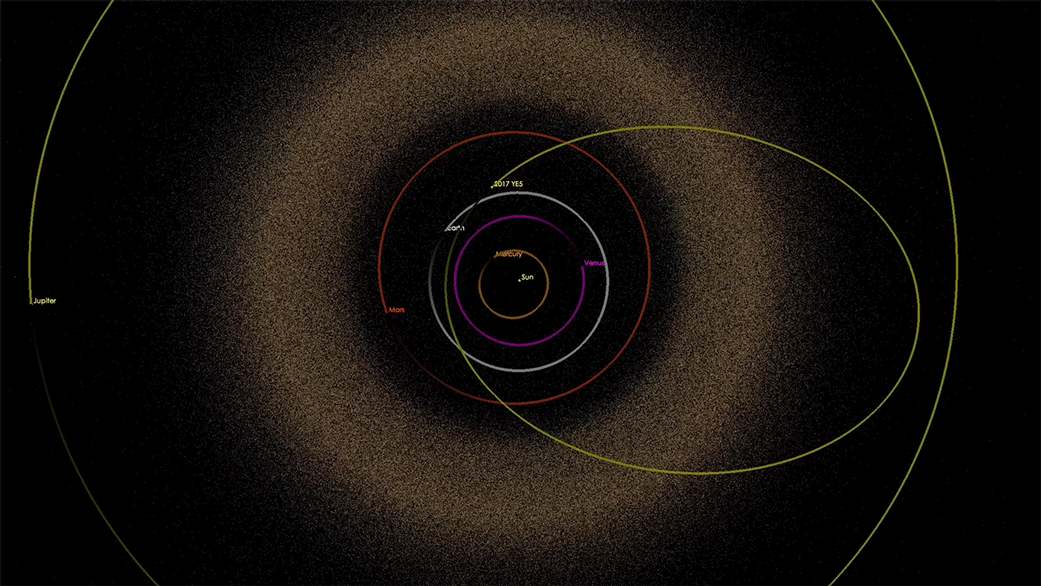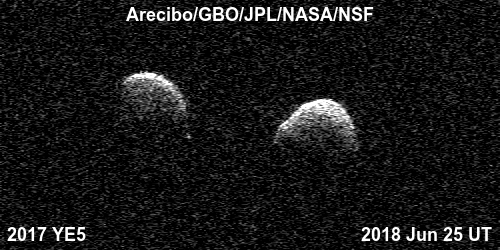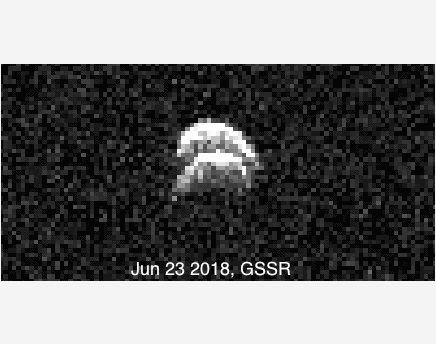New observations by three of the world’s largest radio telescopes have revealed something new about an asteroid with a great name: 2017 YE5. This object, which swept by Earth late in June, 2018, is actually two bodies orbiting a common center of gravity. Each little world is about 3,000 feet (900 meters) in size. Radar observations show these space rocks have similar sizes, but hint that the two objects may be very different in composition and densities. In fact, NASA astronomers suggest one or both space rocks could be extinct Jupiter-family comets.
The Arecibo Observatory in Puerto Rico, along with the Goldstone Solar System Radar in California and the Green Bank Observatory in West Virginia, combined their efforts to study this object as it swept closest to us in June. The studies showed not one but two objects, about equal in mass. This is only the fourth equal-mass-binary, near-Earth asteroid ever detected.
Also, the recent studies revealed the two tiny worlds in the 2017 YE5 system revolve around each other once every 20 to 24 hours. And they showed the objects do not reflect as much sunlight as a typical rocky asteroid. In fact, scientists said, 2017 YE5 is likely as dark as charcoal.

Astronomers with the Morocco Oukaimeden Sky Survey (MOSS) discovered the near-Earth asteroid 2017 YE5 on December 21, 2017. But the object(s) didn’t come closest to us until June 21, 2018. The June close approach was the closest this little system will come to Earth for at least the next 170 years, about 15.5 lunar distances (within 3.7 million miles, or 6 million km). The approach was close enough to provide a good opportunity for radar observations, and even for optical observations, as the asteroid reached a visual magnitude of 15.
Scientists estimate that among near-Earth asteroids larger than 650 feet (200 meters) in size, about 15 percent are binaries with one larger object and a much smaller satellite. Equal-mass binaries like 2017 YE5 are much rarer.
Contact binaries – where two similarly sized objects actually touch each other – are thought to make up another 15 percent of near-Earth asteroids larger than 650 feet (200 meters) in size.

Here’s how three of the world’s largest observatories teamed up to make the discovery, according to a statement from NASA/JPL:
On June 21 and 22, observations by NASA’s Goldstone Solar System Radar (GSSR) in California showed the first signs that 2017 YE5 could be a binary system. The observations revealed two distinct lobes, but the asteroid’s orientation was such that scientists could not see if the two bodies were separate or joined. Eventually, the two objects rotated to expose a distinct gap between them.
Scientists at the Arecibo Observatory in Puerto Rico had already planned to observe 2017 YE5, and they were alerted by their colleagues at Goldstone of the asteroid’s unique properties. On June 24, the scientists teamed up with researchers at the Green Bank Observatory (GBO) in West Virginia and used the two observatories together in a bi-static radar configuration (in which Arecibo transmits the radar signal and Green Bank receives the return signal). Together, they were able to confirm that 2017 YE5 consists of two separated objects. By June 26, both Goldstone and Arecibo had independently confirmed the asteroid’s binary nature.
The new observations obtained between June 21 and 26 indicate that the two objects revolve around each other once every 20 to 24 hours. This was confirmed with visible-light observations of brightness variations by Brian Warner at the Center for Solar System Studies in Rancho Cucamonga, California.
Radar imaging shows that the two objects are larger than their combined optical brightness originally suggested, indicating that the two rocks do not reflect as much sunlight as a typical rocky asteroid. 2017 YE5 is likely as dark as charcoal. The Goldstone images taken on June 21 also show a striking difference in the radar reflectivity of the two objects, a phenomenon not seen previously among more than 50 other binary asteroid systems studied by radar since 2000. (However, the majority of those binary asteroids consist of one large object and a much smaller satellite.) The reflectivity differences also appear in the Arecibo images and hint that the two objects may have different densities, compositions near their surfaces, or different surface roughnesses.

Bottom line: Asteroid 2017 YE5, which swept by Earth in late June 2018, has been observed to be a rare double asteroid – only the fourth “equal mass” binary near-Earth asteroid ever detected,











